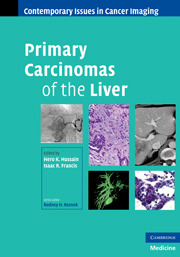Book contents
- Frontmatter
- Contents
- Contributors
- Series foreword
- Preface to Primary Carcinomas of the Liver
- 1 Epidemiology of hepatocellular carcinoma and cholangiocarcinoma
- 2 Surveillance and screening for hepatocellular carcinoma
- 3 Pathology of hepatocellular carcinoma, cholangiocarcinoma, and combined hepatocellular-cholangiocarcinoma
- 4 Radiological diagnosis of hepatocellular carcinoma
- 5 Staging of hepatocellular carcinoma
- 6 Surgical treatment of hepatocellular carcinoma: resection and transplantation
- 7 Non-surgical treatment of hepatocellular carcinoma
- 8 Radiological identification of residual and recurrent hepatocellular carcinoma
- 9 Radiological diagnosis of cholangiocarcinoma
- 10 Staging of cholangiocarcinoma
- 11 Treatment of cholangiocarcinoma
- 12 Uncommon hepatic tumors
- Index
- Color plates
Series foreword
Published online by Cambridge University Press: 04 August 2010
- Frontmatter
- Contents
- Contributors
- Series foreword
- Preface to Primary Carcinomas of the Liver
- 1 Epidemiology of hepatocellular carcinoma and cholangiocarcinoma
- 2 Surveillance and screening for hepatocellular carcinoma
- 3 Pathology of hepatocellular carcinoma, cholangiocarcinoma, and combined hepatocellular-cholangiocarcinoma
- 4 Radiological diagnosis of hepatocellular carcinoma
- 5 Staging of hepatocellular carcinoma
- 6 Surgical treatment of hepatocellular carcinoma: resection and transplantation
- 7 Non-surgical treatment of hepatocellular carcinoma
- 8 Radiological identification of residual and recurrent hepatocellular carcinoma
- 9 Radiological diagnosis of cholangiocarcinoma
- 10 Staging of cholangiocarcinoma
- 11 Treatment of cholangiocarcinoma
- 12 Uncommon hepatic tumors
- Index
- Color plates
Summary
Imaging has become pivotal in all aspects of the management of patients with cancer. At the same time, it is acknowledged that optimal patient care is best achieved by a multidisciplinary team approach. The explosion of technological developments in imaging over the past years has meant that all members of the multidisciplinary team should understand the potential applications, limitations, and advantages of all the evolving and exciting imaging techniques. Equally, to understand the significance of the imaging findings and to contribute actively to management decisions and to the development of new clinical applications for imaging, it is critical that the radiologist should have sufficient background knowledge of different tumors. Thus the radiologist should understand the pathology, the clinical background, the therapeutic options, and the prognostic indicators of malignancy.
Contemporary Issues in Cancer Imaging–A Multidisciplinary Approach aims to meet the growing requirement for radiologists to have detailed knowledge of the individual tumors about which they are involved in making management decisions. A series of single subject issues, each of which is dedicated to a single tumor site, edited by recognized expert guest editors, include contributions from basic scientists, pathologists, surgeons, oncologists, radiologists, and others.
Although the series is written predominantly for the radiologist, it is hoped that individual issues will contain sufficient varied information so as to be of interest to all medical disciplines and to other health professionals managing patients with cancer.
- Type
- Chapter
- Information
- Primary Carcinomas of the Liver , pp. ix - xPublisher: Cambridge University PressPrint publication year: 2009

